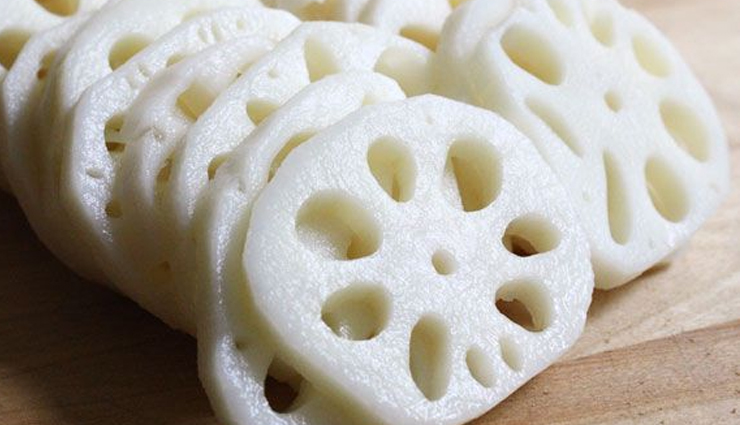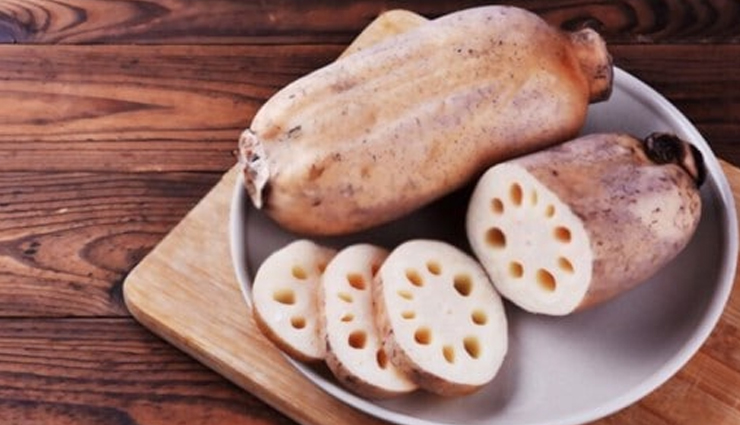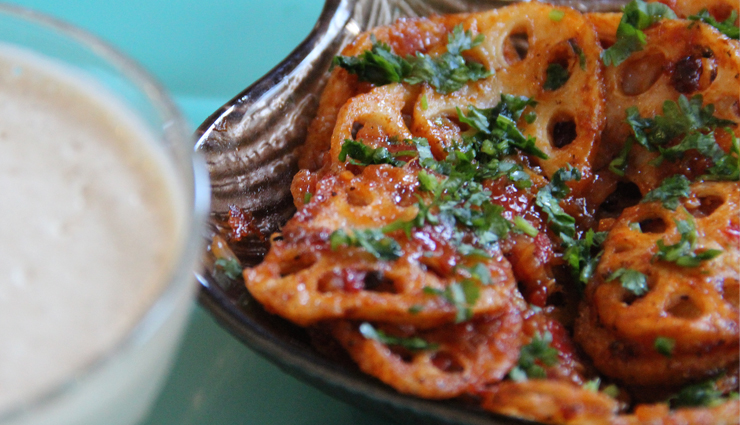- Home›
- Healthy Living›
- 10 Amazing Health Benefits Of Lotus Root, Nutrition Facts, And Drawbacks
10 Amazing Health Benefits Of Lotus Root, Nutrition Facts, And Drawbacks
By: Priyanka Maheshwari Thu, 12 Oct 2023 12:38:10

Lotus root, also known as "renkon" in Japanese or "lian ou" in Chinese, is a unique and versatile vegetable that comes from the rhizome of the lotus plant, scientifically known as Nelumbo nucifera. It has been a staple in Asian cuisine for centuries and is gaining popularity in other parts of the world due to its delicious taste and numerous health benefits.
The lotus root is characterized by its distinctive appearance, featuring a series of holes or chambers running through its length, resembling a string of connected sausage-like segments. These segments are often sliced into thin, round discs, revealing a beautiful pattern that resembles a delicate lacework.
Lotus root has a mild, slightly sweet flavor and a crisp, crunchy texture when cooked. It can be prepared in a variety of ways, such as stir-frying, deep-frying, boiling, or pickling. Its versatility in the kitchen makes it a popular ingredient in salads, soups, stews, and side dishes.
Beyond its culinary appeal, lotus root is known for its nutritional value. It is a good source of dietary fiber, vitamins, and minerals, including vitamin C, vitamin B6, potassium, and manganese. Lotus root is also praised for its potential health benefits, which may include improved digestion, enhanced immune function, and reduced inflammation.

Nutrition Facts Of Lotus Root
100 g of Lotus Root contain the following nutrients:
Calories: Approximately 74 kcal
Carbohydrates: About 17.2 g
Dietary Fiber: Around 4.9 g
Sugars: Approximately 0.7 g
Protein: Roughly 2.6 g
Fat: Nearly 0.1 g
Vitamins and Minerals:
Vitamin C: About 44 mg (74% DV)
Vitamin B6 (Pyridoxine): Approximately 0.3 mg (16% DV)
Thiamin (Vitamin B1): Roughly 0.1 mg (8% DV)
Riboflavin (Vitamin B2): Around 0.1 mg (6% DV)
Niacin (Vitamin B3): Approximately 0.4 mg (2% DV)
Pantothenic Acid (Vitamin B5): About 0.3 mg (6% DV)
Folate (Vitamin B9): Roughly 8 mcg (2% DV)
Potassium: Around 556 mg (16% DV)
Phosphorus: Approximately 45 mg (6% DV)
Iron: About 0.8 mg (10% DV)
Magnesium: Roughly 13 mg (4% DV)

# Rich in Dietary Fiber
Lotus root provides a rich source of dietary fiber, a crucial element for maintaining digestive well-being. Dietary fiber plays a vital role in encouraging consistent bowel movements, averting constipation, and nurturing a balanced and thriving gut microbiome.
# Improved Digestion
The dietary fiber in lotus root can aid in digestion by promoting regular bowel movements and preventing digestive issues such as constipation. It also helps maintain a healthy balance of gut bacteria.

# Vitamins and Minerals
Lotus root contains essential vitamins and minerals, including vitamin C, vitamin B6, potassium, and manganese. Vitamin C is known for its immune-boosting properties, while potassium helps regulate blood pressure and supports heart health.
# Heart Health
The potassium in lotus root is beneficial for heart health, as it helps regulate blood pressure and reduce the risk of cardiovascular diseases.

# Anti-Inflammatory Properties
Some compounds found in lotus root have anti-inflammatory properties, which may help reduce inflammation in the body. This can be beneficial for individuals with conditions such as arthritis or inflammatory bowel disease.

# Weight Management
The high fiber content of lotus root can contribute to feelings of fullness, potentially aiding in weight management by reducing overeating and promoting satiety.

# Lower Cholesterol
Some studies suggest that lotus root may have a positive impact on cholesterol levels. The fiber and phytonutrients in lotus root can help lower LDL (bad) cholesterol levels.

# Blood Sugar Regulation
Lotus root's low glycemic index and fiber content can help regulate blood sugar levels, making it a suitable food choice for individuals with diabetes or those looking to prevent blood sugar spikes.

# Aid in Skin Health
The vitamin C in lotus root is important for the synthesis of collagen, which plays a vital role in maintaining healthy skin. It can also protect the skin from oxidative stress and signs of premature aging.

# Antioxidant Properties
Lotus root contains antioxidants that help protect cells from damage caused by free radicals, potentially reducing the risk of chronic diseases and supporting overall health.
Including Lotus root in your diet consistently can unlock these benefits. Keep reading to explore further on how you can incorporate Lotus root into your meals.

# Stir Fried Lotus Root in Garlic Sauce
Ingredients
2 medium lotus roots, peeled and sliced into thin rounds
2 tablespoons vegetable oil
3 cloves garlic, minced
1 tablespoon soy sauce
1 tablespoon oyster sauce (for a vegetarian/vegan option, use mushroom sauce)
1 teaspoon sugar
1/2 teaspoon sesame oil
Salt and pepper, to taste
Optional: sliced green onions and sesame seeds for garnish
Method
- Peel the lotus roots and slice them into thin rounds. If the rounds are large, you can cut them into halves or quarters to make them more bite-sized.
- In a pot of boiling water, blanch the lotus root slices for about 3-4 minutes until they are slightly tender but still have a crunch. Drain and set aside.
- In a small bowl, mix together the soy sauce, oyster sauce, sugar, and sesame oil. Stir until the sugar is dissolved. This is your garlic sauce.
- Heat the vegetable oil in a large pan or wok over medium-high heat. Add the minced garlic and stir-fry for about 30 seconds until it becomes aromatic.
- Add the blanched lotus root slices to the pan. Stir-fry for 2-3 minutes until they are well-coated with the garlic and oil.
- Pour the prepared garlic sauce over the lotus root. Toss to coat the lotus root slices evenly with the sauce. Cook for an additional 2-3 minutes, allowing the flavors to meld and the lotus root to absorb the sauce.
- Taste and adjust the seasoning with salt and pepper if necessary. If you prefer a bit of heat, you can add a pinch of red pepper flakes. Garnish with sliced green onions and sesame seeds if desired.
- Transfer the stir-fried lotus root to a serving dish. Serve hot as a side dish or over steamed rice as a main course.

# Lotus Root Manchurian
Ingredients
For Lotus Root Fritters:
1 medium lotus root, peeled and thinly sliced into rounds
1/2 cup all-purpose flour
2 tablespoons cornstarch
1 teaspoon ginger-garlic paste
1/2 teaspoon red chili powder
Salt, to taste
Water, as needed
Oil for deep frying
For Manchurian Sauce:
1 tablespoon vegetable oil
1 onion, finely chopped
1 bell pepper, thinly sliced
3-4 cloves garlic, minced
1 teaspoon ginger, minced
2 tablespoons soy sauce
1 tablespoon tomato ketchup
1 tablespoon chili sauce (adjust to taste)
1 tablespoon cornstarch mixed with 3 tablespoons water (for thickening)
1/2 teaspoon black pepper powder
Salt, to taste
1 green onion, chopped (for garnish)
Method
For Lotus Root Fritters:
- In a mixing bowl, combine all-purpose flour, cornstarch, ginger-garlic paste, red chili powder, and salt. Gradually add water and mix to form a smooth batter.
- Heat oil in a deep pan over medium-high heat. Dip lotus root slices into the batter, making sure they are well coated, and deep fry until golden brown and crispy. Remove and drain excess oil on a paper towel. Set aside.
For Manchurian Sauce:
- Heat 1 tablespoon of oil in a pan over medium heat. Add chopped onions and sauté until they turn translucent.
- Add minced garlic and ginger. Sauté for a minute until fragrant.
- Add sliced bell peppers and cook for a couple of minutes until they are slightly tender but still crisp.
- Add soy sauce, tomato ketchup, chili sauce, black pepper powder, and salt. Mix well.
- In a small bowl, mix cornstarch with water to create a slurry. Add the slurry to the pan to thicken the sauce. Stir continuously to avoid lumps.
- Add the fried lotus root fritters to the sauce. Toss gently until the fritters are well coated with the sauce.
- Garnish with chopped green onions.
- Remove from heat and serve hot as an appetizer or a side dish.

# Crispy Chilli Garlic Lotus Root Recipe
Ingredients
1 medium lotus root, peeled and thinly sliced into rounds
1/2 cup cornstarch
1/2 teaspoon salt, or to taste
1/2 teaspoon black pepper powder
Oil for deep frying
For Chilli Garlic Sauce:
2 tablespoons vegetable oil
4-5 cloves garlic, minced
2-3 green chilies, thinly sliced (adjust to taste)
1/4 cup soy sauce
1 tablespoon tomato ketchup
1 tablespoon chili sauce (adjust to taste)
1 tablespoon honey or brown sugar
1 teaspoon rice vinegar or white vinegar
1 green onion, chopped (for garnish)
Sesame seeds (optional, for garnish)
Method
For Crispy Lotus Root:
- In a bowl, combine cornstarch, salt, and black pepper powder. Coat the lotus root slices evenly with the cornstarch mixture.
- Heat oil in a pan or deep fryer over medium-high heat. Fry the lotus root slices in batches until golden brown and crispy. Remove with a slotted spoon and drain excess oil on paper towels. Set aside.
For Chilli Garlic Sauce:
- Heat 2 tablespoons of vegetable oil in a pan over medium heat. Add minced garlic and sliced green chilies. Sauté until the garlic is golden brown and aromatic.
- Add soy sauce, tomato ketchup, chili sauce, honey (or brown sugar), and rice vinegar. Stir well to combine all the ingredients. Let it simmer for a few minutes until the sauce thickens slightly.
- Add the crispy lotus root slices to the pan. Toss gently until the lotus root is well coated with the chilli garlic sauce.
- Garnish with chopped green onions and sesame seeds (if using).
- Remove from heat and serve hot as an appetizer or a side dish.
Drawbacks of Lotus Root
- Lotus root contains a significant amount of starch, which means it is relatively high in carbohydrates. Individuals on low-carb or ketogenic diets should consume it in moderation.
- Due to its starch content, lotus root can be calorie-dense. People looking to manage their weight should be mindful of portion sizes.
- Some individuals might be allergic to lotus root. If you experience any allergic reactions like itching, swelling, or difficulty breathing after consuming lotus root, consult a healthcare professional.
- Lotus root contains oxalates, which can crystallize in body fluids and cause health problems in individuals with certain health conditions, such as kidney or gallbladder issues. People prone to oxalate-containing kidney stones should avoid excessive consumption.
- Preparing lotus root can be time-consuming and requires careful cleaning, peeling, and slicing. Also, if not cooked properly, it can be slightly bitter.





